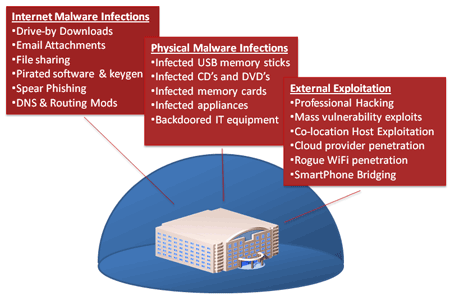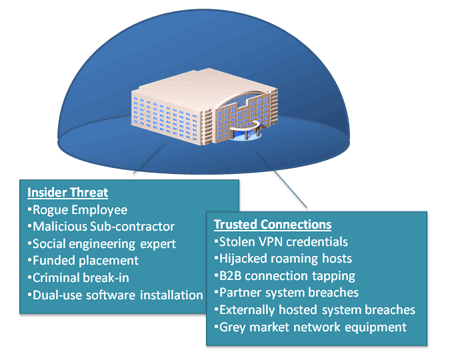You are here
Home > Advanced Persistent Threats (APTs)Advanced Persistent Threats (APTs)
Advanced Persistent Threats (APTs)
APTs are a cybercrime category directed at business and political targets. APTs require a high degree of stealth over a prolonged duration of operation in order to be successful. The attack objectives therefore typically extend beyond immediate financial gain, and compromised systems continue to be of service even after key systems have been breached and initial goals reached.
How Advanced Persistent Threats Breach Enterprises:
APTs breach enterprises through a wide variety of vectors, even in the presence of properly designed and maintained defense-in-depth strategies:
- Internet-based malware infection
- Physical malware infection
- External exploitation

Well-funded APT adversaries do not necessarily need to breach perimeter security controls from an external perspective. They can, and often do, leverage “insider threat” and “trusted connection” vectors to access and compromise targeted systems.
Abuse and compromise of “trusted connections” is a key ingredient for many APTs. While the targeted organization may employ sophisticated technologies in order to prevent infection and compromise of their digital systems, criminal operators often tunnel in to an organization using the hijacked credentials of employees or business partners, or via less-secured remote offices. As such, almost any organization or remote site may fall victim to an APT and be utilized as a soft entry or information harvesting point.

A key requirement for APTs (as opposed to an “every day” botnet) is to remain invisible for as long as possible. As such, the criminal operators of APT technologies tend to focus on “low and slow” attacks – stealthily moving from one compromised host to the next, without generating regular or predictable network traffic – to hunt for their specific data or system objectives. Tremendous effort is invested to ensures that malicious actions cannot be observed by legitimate operators of the systems.
While APT malware can remain stealthy at the host level, the network activity associated with remote control is more easily identified. As such, APT’s are most effectively identified, contained and disrupted at the network level.









